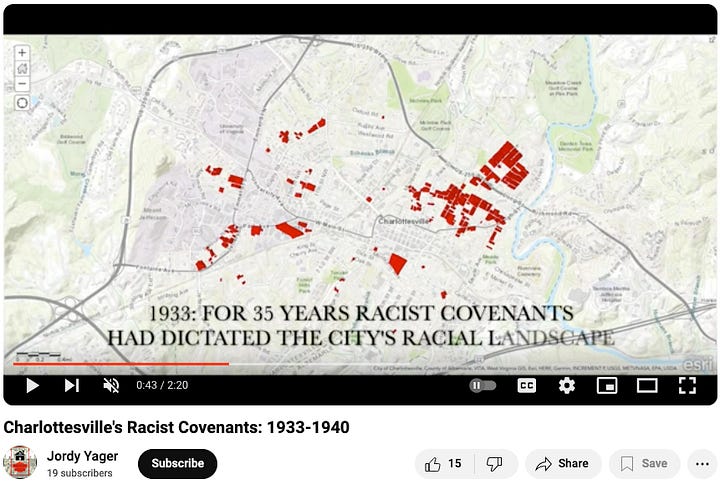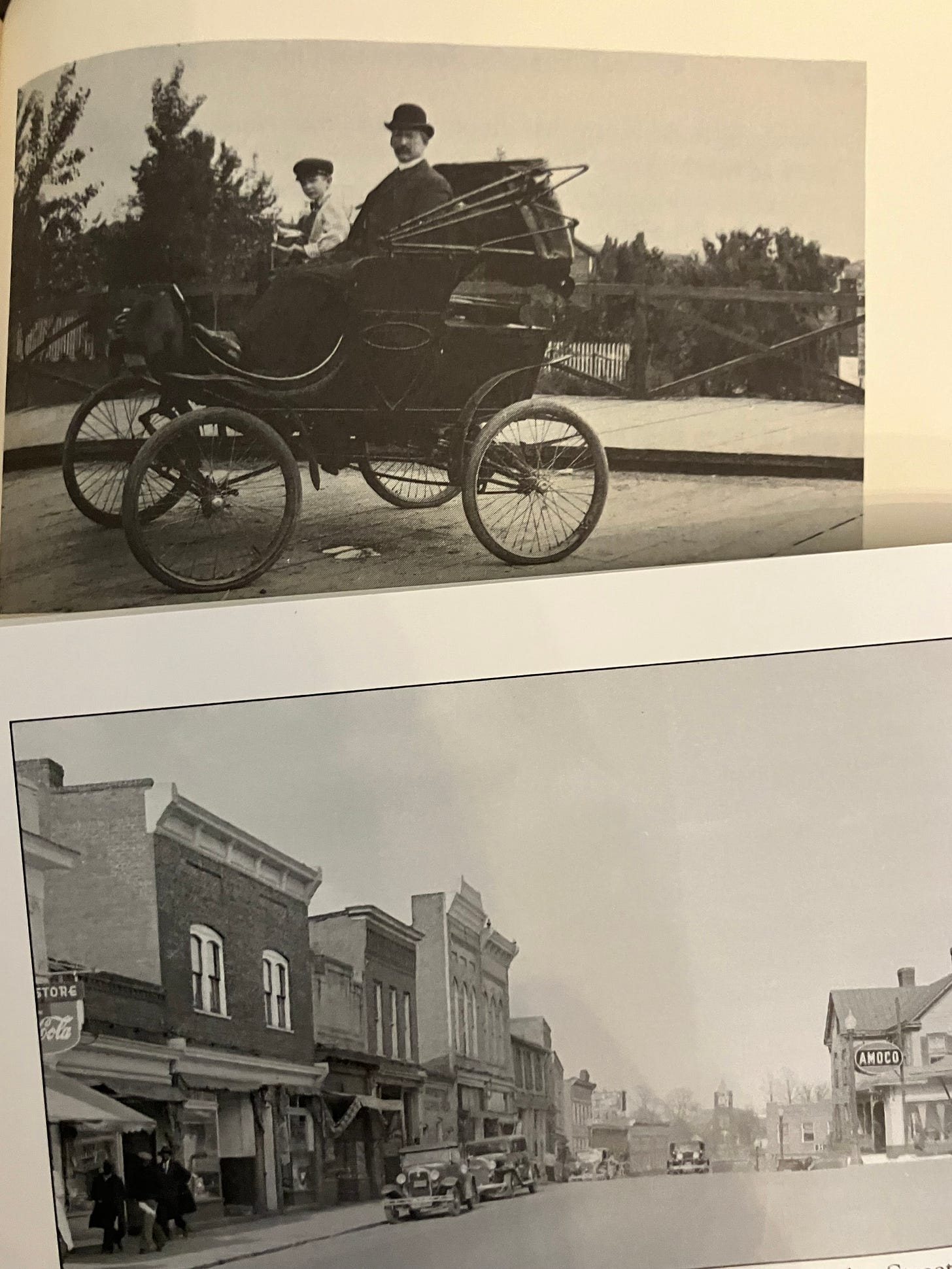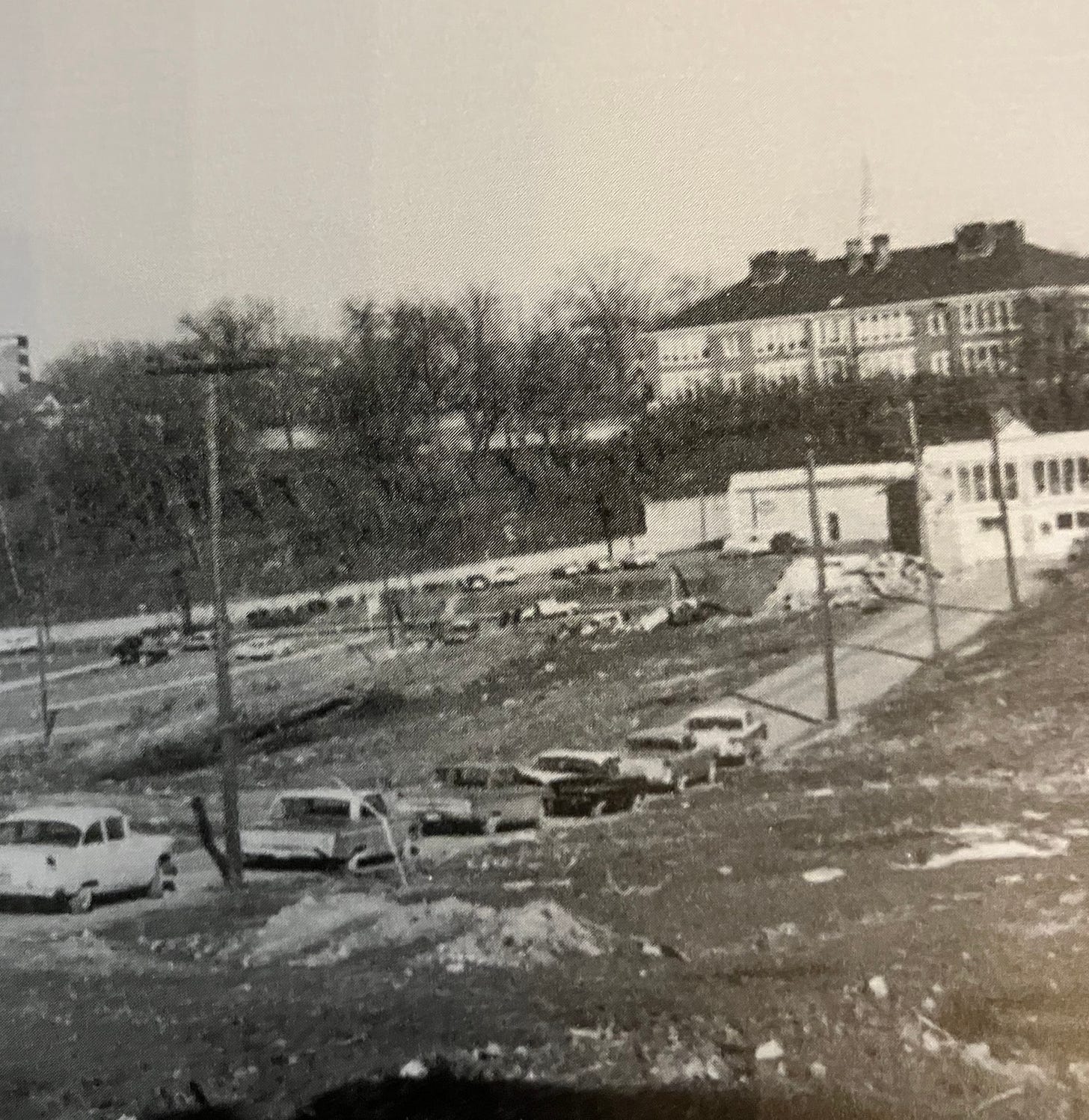Cville Drives
Part 12 of Welcome to Charlottesville, a weekly visit to a town, a failed art project, and the future of America.
The Automobile
In the fifty years after 1910 three major innovations radically changed how the people of Charlottesville lived with one another. The third was a type of government socialism that even conservatives defend. The second was new forms of racial discrimination. The first is the automobile.
Cars did not create modern life as did electric lights, hot and cold running water, heat and air conditioning, refrigerators, telephones, railroads, commercial navigation, and airplanes.1 I’ve lived in cities where most people didn’t drive cars—Athens, Greece; Prague, Czech Republic; and New York City—and life wasn’t particularly different, but living in a cabin without heat—that was different.
Yet cars subtly influence a lot.
In 1909 there were still only seven automobiles in the area. Cars were toys for tinkers and hobbyists. But then Detroit developed manufacturing techniques to make cars cheap, and by 1920 there were two thousand cars and trucks, and the number continued to climb ever since.
By the way, I drive a car myself and can’t imagine Charlottesville life without driving, so when pointing out the effects of cars I’m not pointing fingers, just stating facts:
Cars privatize streets. When life was based on horses, it was really based on feet (see here). Streetcars, horses, and people shared streets, kids played in them, neighbors chatted in them, peddlers sold goods in them. But cars not only take over the street, they widen it till the sidewalks get thinner and thinner.
Cars shred the 4th Amendment. Streets may be public spaces in theory but to drive on them we need to be able to afford a car, and then we need to have a license and insurance. Driving is a “privilege” as Virginia often reminds us. And police can’t get warrants to search cars when they’re pulled over, so we’ve developed a parallel legal system where they don’t have to.
Cars erase political loyalties. Before cars people tended to live in the same constituency where they worked and shopped. Cars mean anyone can live anyplace where a government is willing to build and maintain a road. With a car people can live right outside a city, gaining the economic benefits of it but not paying for the infrastructure that makes those economic benefits possible.
Cars create pollution that is linked to various health problems. But I’ll not take this up here.2
Cville before it’s eaten
In the 1910s Charlottesville experienced its fastest growth since the 1880s, increasing by 50% in ten years. Virginia issued a proclamation on August 1, 1916 declaring that Charlottesville was a first-class city, the population having passed the 10,000 threshold. It would double again by 1940 and double again by the end of the 1960s.
In 1910 the city annexed land, including the Rose Hill neighborhood, the University area, much of Ridge Street, Belmont out to Belmont Park, and the area around Locust Avenue. The latter, dubbed “Locust Grove,” would soon be Charlottesville’s first explicitly whites-only segregated neighborhood.
Despite its small size Cville was bustling. The Levy Opera House competed with the new 1912 Jefferson Theater. Then Twyman’s Main Street Entertainment Palace put the Levy out of business. These were vaudeville houses bringing in touring acts from all over the country, plus silent movies. Other movie houses would soon appear as well. What is now the downtown mall was a shopping district that stretched from the C&O railroad station west past the train station on Main Street and on to the University grounds with a tail stretching southwest to Fry Springs. A streetcar ran from downtown out and back. Kitchens acquired the electric lights, ice boxes (similar to fridges), gas stoves, running water and other familiar workings. Monticello opened to the public bringing tourists to the area, Piggly Wiggly, forerunner to the modern supermarket, opened, and telephones were common.
In 1920 the 19th Amendment gave women the right to vote. This may have helped push through a local shift to a managerial form of government in 1922.
In the 1920s local philanthropist Paul Goodloe McIntire (son of the Civil War mayor) donated our library and parks with several statues which became well know.
The Expansion of Segregation
In Virginia public schools were explicitly segregated after the Civil War, and interracial marriage was outlawed immediately after Reconstruction, but as we discussed here, general segregation in housing and public places and the loss of voting rights took decades longer, and as we discussed here, it wasn’t the KKK who imposed it, but mainstream, button-down Democratic politicians. Scottsville’s own Thomas Staples Mann orchestrated the Constitution of 1902 which erased black voting rights and the delivered one-party rule for generations.
In the years that followed the now all-white Democratic governments segregated passenger trains, then streetcars, then hotels and restaurants, and finally in 1912 passed legislation to allow local governments to establish segregated housing. In that year Charlottesville passed an ordinance requiring homeowners in majority white areas to only sell to whites, and homeowners in majority black areas to only sell to blacks. In 1917 the U.S. Supreme Court banned such segregation ordinances, so the segregationists changed tactics.
Zoning
Commentators today often cite zoning as specifically racist in intention, but zoning tended to be more classist. Under the influence of the Garden-City Movement, towns and cities separated neighborhoods into residential, commercial, and industrial. A U.S. Supreme Court decision in 1926 declared zoning did not violate property rights and the practice spread. Charlottesville’s first zoning code was in 1929. Zoning will matter more once we get more cars.
Redlining
During the Great Depression the New Deal Home Owners’ Loan Corporation created maps for mortgage purposes that discriminated against black neighborhoods. This is called “redlining,” but I don’t believe there were such maps of small cities and towns like Charlottesville. Redlining matters if we’re talking about the history of Chicago, but it doesn’t have much to do with Charlottesville.
Restrictive Covenants
Restrictive or Racial Covenants were what mattered here. Builders and sellers would insert a “private” rider into a property’s deed requiring a white purchaser to sell in the future only to whites and to pass the rider on. This reworked segregation ordinances as private agreements that the government allegedly couldn’t do anything about.
The Locust Grove neighborhood was built this way, and over the following decades racial covenants spread to house sales throughout the city. Meadowbrook Hills, in 1923 Fry Springs, Rugby Hills, and beyond.
Speaking of the 1920s, this is when the KKK was recreated as I described here. There was no Reconstruction-era KKK in the area, but the second KKK did. Local chapters formed in 1922 and they were burning crosses in 1924 and setting off bombs two years later. In 1925 they had their own Charlottesville parade.


The Other Invention
The biggest change in 20th century life, the form of socialism everyone seems to love, is the longterm mortgage.
Before the New Deal a mortgage was basically pawning your house. (Like in the game Monopoly.) You have 5 or 10 years to pay back the loan or the mortgage lender got your house. So houses were not purchased using mortgages. The most common method, other than saving money in a sock, buying land, and then building a house piece by piece,4 was to purchase membership in a Building and Loan Association which would include a 12-year loan. B&Ls are bizarre organizations you can read about here. But there also irrelevant organizations because they mostly went under during the Great Depression. Anyway you’ll notice starter homes built before the Great Depression tend to small, because the down payment was higher and the loan was much shorter-term.
So FDR became president and his administration created several housing programs:
The Home Owners' Loan Corporation (HOLC) bailed out suffering homeowners by paying off their loans and signing them to new 15-year loans.
The Federal Housing Administration offered backing to lending institutions who offered highly-regulated but guaranteed-profitable 20-30 year mortgages. The banks could be sure of steady income, the government could get people into homes, the construction business could get going again. Eventually, private lenders began offering similar long-term products to compete.
Loans to builders. Many of the old B&Ls became Savings and Loans specializing in building loans and banks lent too. Knowing there were guaranteed buyers and federal insurance, money was lent to builders to build new housing. This was a highly regulated process requiring the builders to adhere to strict standards which included building single-family homes, garden-city-style zoning, setbacks and easements, and racial segregation.
To get all this through Congress the New Deal required programs not to anger racist lawmakers. This effectively spread segregation across the entire country. If you’re a developer building houses for white people you get a bank loan and your buyers will be able to get mortgages, but if you’re a developer building houses for black people you won’t get a bank loan because your buyers won’t be able to get mortgages.
After WWII all this came together, a massive amount of housing was built with federal-back financing for white people, first in the Northern cities where the defense industries had been located and by the 1950s in places like Charlottesville. 1963 was the city’s last major annexation including Greenbriar, Barracks Road, and Cherry Avenue.
The Ponzi Scheme
The United States was the only major power that survived WWII with its industrial base intact. Its navy ruled the seas, it created the world financial system at Bretton Woods, it set up the United Nations, NATO, and scores of other organizations. At home there was an economic boom, and the profits were mostly poured into successive rings of subdivisions which allowed (only white) people to buy houses at monthly rates lower than rentals. Their cost of living got lower and they came out of it owning buildings which they could sell for bigger and more expensives houses in the next ring of suburbs farther out. Middle-class wealth is mostly home ownership so the government’s longterm mortgages meant a huge group of (only white) people became middle class this way. This process influences economics and culture far more today than redlining, zoning, or even racial covenants. I believe it’s more accurate to think of the system as less about discriminating against African Americans and more about giving signficant wealth to a quarter of whites.
What happens if you take that quarter away?

Unfortunately for city budgets, as cars spread things out, they eat up space with non-remunerative roads and parking lots while vastly increasing costs. The first car-based cities in America were Detroit and its suburbs (such as Flint) in the 20s. These cities were struggling financially by the early 60s. In the 40s California cities took this up and were struggling financially by the late 1970s. We got started later, so we have a ways to go, but Detroit is the future of all auto-based cities.
Meanwhile the late 50s and 60s brought some positive changes:
The End of Segregation
WWII reignited the Civil Rights movement (really movements, plural) that had been beaten down in the South.5 In 1952 students in Prince Edward County rebelled against their terrible segregated schools, and that opposition was one of the core cases bundled into the Brown vs Board of Education Supreme Court decision outlawing separate schools as inherently unequal.
Southern governments started looking for loopholes and stalling tactics. Virginia actually closed down its schools rather than integrate. (This is when quite a few of our local private schools were founded.) The state caved in 1959 and Virginia schools—the institution that first began segregation—reopened and integrated.
Meanwhile Vinegar Hill, a mixed-used, predominantly black neighborhood along Main Street was bulldozed as part of urban renewal.6
In 1967 the Supreme Court in Loving v Virginia struck down state laws against intermarriage.
In 1968 the Supreme Court in Jones v. Alfred H. Mayer Co effectively ended racial or residential covenants. This was backed up by the Fair Housing Act of 1968.
That brings our history thread up to about when I first moved here. I was too young to have any awareness of all that was going on, but my mom remembers that the first apartment complex we moved into had no black tenants. Then she landed a job as a property manager, the first property manager of the new Hessian Hills Apartments as they were being built, and she remembers renting to a black couple, and her boss, the owner of the complex, was unsettled but did not overtly object.
Driving
Automobiles opened up all of Albemarle County for development, which increased property values and therefore taxes and led to the steep decline in farming. In the beginning of our period a third of the population was involved in farming. By 1960 it was 14%, and only 5% by the end of our period.
Cars mean that most of us drive to work or school, then drive to shop, then drive home, and rarely interact face-to-face with a general public as we would if we walked. That can be great or that can be lonely. Cars mean our leaders don’t have to face an angry mob as urban leaders used to. And since neighborhoods are usually built all at once at a particular price point, and politics is tied to place and class, many of us spend our lives with people of similar points of view. That can be great or terrible too.
In the next three Tuesdays we’ll take up the fifth time I move to Charlottesville (which hasn’t happened yet), then the lessons and aftermath of the Police Stories project, and finally Welcome to Charlottesville will finish with the future of the city itself.
Thanks for reading Blame Cannon! This has been Part 8 of Welcome to Charlottesville. Here are the sections in order: Part 1, Part 2, Part 3, Part 4, Part 5, Part 6, Part 7, Part 8, Part 9, Part 10, Part 11. Here’s an index if you’re looking for a place to get started.
Please subscribe and share!
Comments are welcome but please no personal insults or profanity!
Throw in radios, radar, sound recordings, and movies too. Radios may not seem like they matter as much as cars, but radios are used by the ships and airplanes.
Horses also created pollution and accidents, but cars seem to be worse since as I said horse-cultures are actually mostly foot cultures, so a lot less time was spent in horses and wagons than we spend in cars.
The interstate highway system is an especially dramatic demonstration of what cars do. Follow the link to a depressing series of before and after pictures.
Sears Roebuck started selling house kits in 1908. They would be sent by railroad and then delivered to the site by mules or oxen.
The Charlottesville Inter-Racial Commission first met in 1942, and eventually became the Virginia Council on Human Relations.
This has been talked about a lot in the Charlottesville area, and I might return to it in a future post. Former Charlottesvillian Teresa Dowell-Vest has a play about Vinegar Hill that was staged at Live Arts when I was working there. Maybe we’ll ask her to share it.





